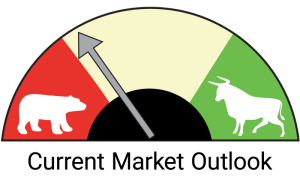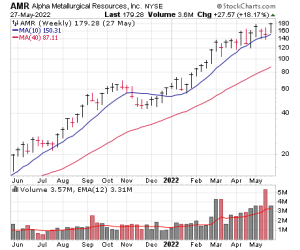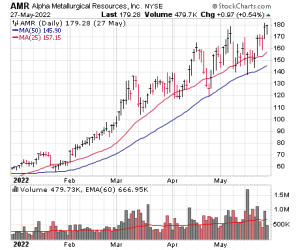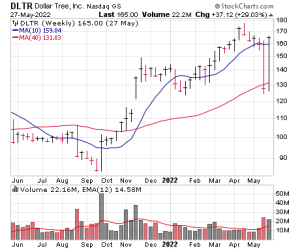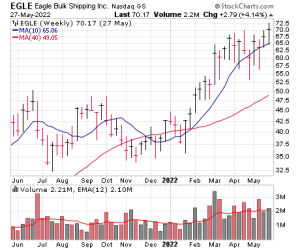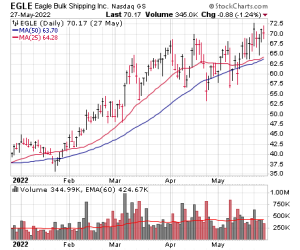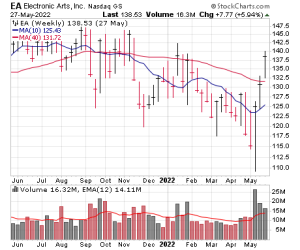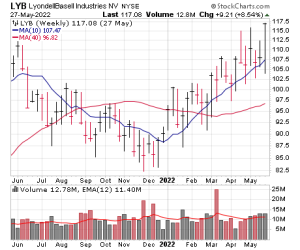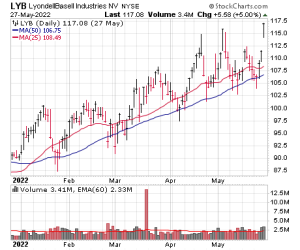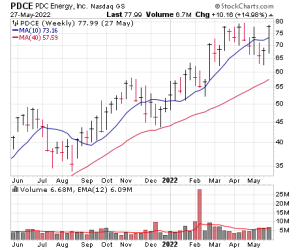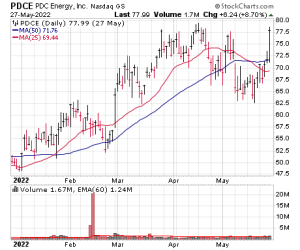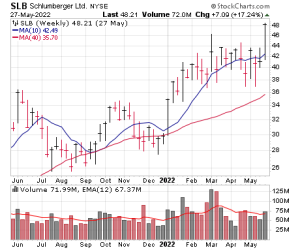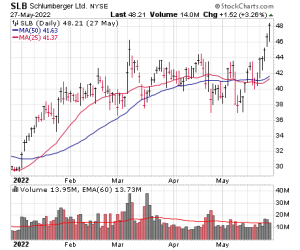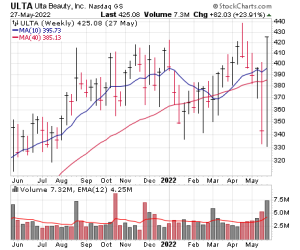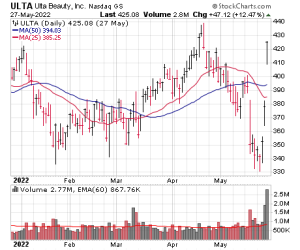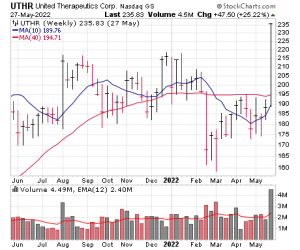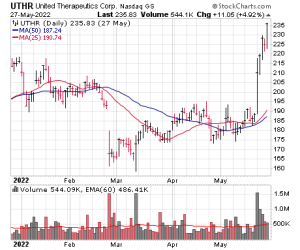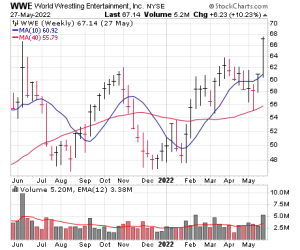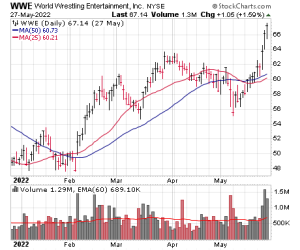During the past couple of weeks, the market has put together a handful of solid baby steps; in fact, the rally has been enough to put the intermediate trend on watch—a bit more strength from here could produce a green light. That’s all to the good, but (a) we still have to see the signal actually occur, and (b) even if it comes, there’s still plenty of overhead to chew through given the damage seen over the past few months. That’s not to throw cold water on the rally attempt—we’re nudging up our Market Monitor to a level 3 tonight, but right now, it’s best to remain defensive and to go slow on the buy side.
This week’s list is again heavy on commodity-related stocks and special situations, along with some recent earnings winners sprinkled in. Our Top Pick is a medical firm that lifted above long-time resistance following a clean FDA approval.
Cabot Top Ten Trader Issue: May 31, 2022
DOWNLOAD ISSUE PDF
Keep it Simple
During the past couple of weeks, the market has put together a handful of solid baby steps, with some decent internal strength (3 straight days of at least 80% up volume and at least 70% up issues on the NYSE to finish last week) and some solid action among potential leaders, too. In fact, the rally has been enough to put the intermediate trend on watch—some more strength over the next few days from here could produce a green light. That’s all to the good, but (a) we still have to see the signal actually occur, and (b) even if it comes, there’s plenty of overhead to chew through given the damage seen over the past few months. That’s not to throw cold water on the rally attempt—we’re nudging up our Market Monitor to a level 3 tonight, and if the strength continues, we’ll likely bump it up another couple of notches. But right now, it’s best to remain defensive, but also flexible, and to go slow on the buy side as we look for confirmation that the storm has passed.
This week’s list is again heavy on commodity-related stocks and special situations, along with some recent earnings winners sprinkled in. Our Top Pick is United Therapeutics (UTHR), which just leapt out of a long consolidation following broad approval by the FDA for one of its newer treatments.
| Stock Name | Price | Buy Range | Loss Limit |
| Alpha Metallurgical (AMR) | 162 | 155-163 | 134-138 |
| Dollar Tree (DLTR) | 160 | 155-161 | 139-142 |
| Eagle Bulk Shipping (EGLE) | 73 | 68.5-71.5 | 60-62 |
| Electronic Arts (EA) | 139 | 134-137 | 122-124 |
| Lyondellbasell (LYB) | 114 | 111-114 | 101-103 |
| PDC Energy (PDCE) | 79 | 76-79 | 67-69 |
| Schlumberger (SLB) | 46 | 44.5-46.5 | 39.5-41 |
| Ulta Beauty (ULTA) | 423 | 410-420 | 370-375 |
| United Therapeutics (UTHR) ★ TOP PICK ★ | 230 | 224-230 | 200-205 |
| World Wrestling (WWE) | 67 | 65-67 | 58.5-59.5 |
Stock 1
Alpha Metallurgical (AMR)
| Price | Buy Range | Loss Limit |
| 162 | 155-163 | 134-138 |
Why the Strength
As Covid restrictions ease in China’s industrial hub of Shanghai (home to some of the world’s largest steelmakers), record high metallurgical coal prices could increase even further. Alpha Metallurgical (covered in the March 21 issue) is one of America’s largest producers of metallurgical, or “met,” coal used for steel production, with underground and surface mining operations across Virginia and West Virginia. Alpha managed to improve on its stellar fourth quarter results in Q1, as revenue came in north of $1 billion, up a whopping 178% from a year ago (and up 29% from Q4), led by a 30% increase in met coal segment sales and helped by average realized coal prices that jumped a similar amount. Per-share earnings of $20.52 beat the consensus by $1.48, while adjusted EBITDA hit a record of over $500 million (more than 15% of the market cap). Alpha indicated that strength in the met coal market has allowed it to “significantly” accelerate progress in deleveraging the balance sheet, with plans to extinguish its term loan in Q2. The company also increased its buyback authorization by another $150 million (to $600 million) and instituted a quarterly dividend at an annualized rate of $1.50 per share (0.85% yield). Going forward, Alpha has committed and priced around 53% of its met coal for 2022 (at $244 per ton) and 96% of thermal coal, while all of its remaining output is fully committed for the year. Management says it should be able to gradually improve the firm’s average coal quality while expanding sales to regions expected to show the most met coal demand. Of note, a short selling outfit took a swing at Alpha recently, but the stock barely budged—indeed, Wall Street sees out-of-this-world earnings this year and, assuming things cool off, nearly $30 in 2023.
Technical Analysis
AMR has had a massive, massive run during the past year, so you’re not in the first inning here, but shares show no real signs of slowing down. Shares raced as high as 165 in mid April before finally having a big shakeout to the 50-day line; since then, AMR has seen a couple more ups and downs (including one today), but the 50-day line held and the stock is perched near new highs. We’re not opposed to a nibble here, though we’d prefer to grab some on a pullback—and be sure to use a loose stop given AMR’s volatility.
| Market Cap | $3.31B | EPS $ Annual (Dec) | |
| Forward P/E | 2 | FY 2020 | -13.20 |
| Current P/E | 5 | FY 2021 | 15.20 |
| Annual Revenue | $2.94B | FY 2022e | 85.96 |
| Profit Margin | 37.4% | FY 2023e | 27.79 |
| Qtrly Rev | Qtrly Rev Growth | Qtrly EPS | Qtrly EPS Growth | |
| ($M) | (vs. yr-ago-qtr) | ($) | (vs.yr-ago-qtr) | |
| Latest qtr | 1072 | 178% | 20.52 | N/A |
| One qtr ago | 828 | 156% | 13.37 | N/A |
| Two qtrs ago | 649 | 93% | 4.43 | N/A |
| Three qtrs ago | 395 | 12% | -1.01 | N/A |
Weekly Chart | Daily Chart |
Stock 2
Dollar Tree (DLTR)
| Price | Buy Range | Loss Limit |
| 160 | 155-161 | 139-142 |
Why the Strength
Rampant inflation is pushing more budget-stretched consumers to do their shopping at deep-discount stores like Dollar Tree. The company, which operates around 16,000 outlets nationwide, also owns the Family Dollar brand where most items are priced under $10. But Dollar Tree’s attraction is that most of its retail offerings typically sell for around $1.25 (up somewhat in recent years), and those bargains are hard to pass up as gas and food prices soar. What’s more, for customers who want to save on gas (or simply don’t want to leave the house), both stores offer one-hour delivery through a partnership with Instacart. Dollar Tree produced jaw-dropping beats in Q1 that compared favorably with results from bigger discount rivals. Revenue of $6.9 billion increased 7% from a year ago and per-share earnings of $2.37 were 37 cents above estimates. While Family Dollar same-store sales were 3% lower, comp store sales for Dollar Tree leaped 11% as customers clearly went for the better bargains. During the quarter, the company opened 112 new stores and expanded or relocated 33 stores with the result being a 3% increase in selling square footage. Although most items at Dollar Tree are still at the $1.25 price point, the company said it’s experimenting with higher-priced offerings (in the $3 to $5 range) with “strong consumer response” to date. Going forward, the company guided for revenue of ~$6.7 billion in Q2 and EPS of ~$1.50, and for the full year, sees comp store sales rising in the mid-single digits in the Dollar Tree segment and being flat for Family Dollar. Both forecasts are likely to surprise Wall Street’s far more conservative estimates, however, as the bargain hunting trend gains traction amid inflation’s persistence—analysts see earnings up 40% this year and double digits in 2023.
Technical Analysis
DLTR raced to new all-time highs in November as investors looked ahead to accelerating growth; after resting for a few weeks, the stock rallied further before hitting a peak of 177 in April. Then came the sector-wide retail crash in May, which came out of left field and caused DLTR to crater to 125—but earnings saved the day last week, with shares immediately recouping the Target-related drop and then some. We’re OK grabbing a few shares in this area.
| Market Cap | $36.9B | EPS $ Annual (Jan) | |
| Forward P/E | 20 | FY 2021 | 6.52 |
| Current P/E | 25 | FY 2022 | 5.80 |
| Annual Revenue | $26.7B | FY 2023e | 8.02 |
| Profit Margin | 4.5% | FY 2024e | 9.10 |
| Qtrly Rev | Qtrly Rev Growth | Qtrly EPS | Qtrly EPS Growth | |
| ($M) | (vs. yr-ago-qtr) | ($) | (vs.yr-ago-qtr) | |
| Latest qtr | 6.9 | 7% | 2.37 | 48% |
| One qtr ago | 7.08 | 5% | 2.01 | -6% |
| Two qtrs ago | 6.42 | 4% | 0.96 | -38% |
| Three qtrs ago | 6.34 | 1% | 1.23 | -23% |
Weekly Chart | Daily Chart |
Stock 3
Eagle Bulk Shipping (EGLE)
| Price | Buy Range | Loss Limit |
| 73 | 68.6-71.5 | 60-62 |
Why the Strength
At some point, the drybulk shipping market will cool off significantly, but there are no signs of that yet—in fact, Q1 is usually the slowest time of the year for the industry, but this year Q1 was very strong with elevated charter rates likely for many quarters to come. Eagle Bulk Shipping is a mid-sized player in the field, with 53 vessels (all either mid-sized ultramax or supramax models, which can carry any type of cargo; 47 have scrubbers, which boosts profitability), but the big story here is the industry—demand remains firm and port congestion issues remain, but the main attraction is fleet growth, which is projected at just 2.2% this year (less for Eagle’s types of ships), while the orderbook remains at or near the lowest levels since 1996. That’s keeping rates up and leading to a gusher of profits: In Q1, Eagle’s sales and earnings were up huge (see table) as the firm’s ships collected an average of $27,400 per day—and because of Eagle’s generous dividend policy, it’s been paying out huge dividends, around $2 per share, per quarter, over the past three quarters. And that figure could be even higher in Q2, as Eagle has already fixed north of 80% of Q2 ships for the quarter at a rate of $29,200 (up more than 6% from Q1). Of course, things can cool off in a hurry in this sector, and shipping rates did dip last week—but so far the Baltic Supramax Index (which correlates well to Eagle’s charter rates) remains in the middle of its multi-month, elevated range, and well off its Q1 lows. It’s not a buy-and-hold-forever situation, but we think there’s upside here as investors discount further big earnings and dividends for the next few quarters.
Technical Analysis
There aren’t a lot of commodity stocks that are sporting good setups, but EGLE is one. The stock consolidated normally from June of last year through January of this year, then took off on the upside, reaching multi-year highs of 69 in early March. Since then, EGLE has basically chopped sideways, with a lot of wiggles between 58 and 72, but the weekly chart seems is firming up after a couple of shakeouts, with shares testing new high ground. We’re OK taking a swing at it here or on dips.
| Market Cap | $968M | EPS $ Annual (Dec) | |
| Forward P/E | 4 | FY 2020 | -3.40 |
| Current P/E | 5 | FY 2021 | 12.18 |
| Annual Revenue | $682M | FY 2022e | 17.84 |
| Profit Margin | 37.5% | FY 2023e | 13.97 |
| Qtrly Rev | Qtrly Rev Growth | Qtrly EPS | Qtrly EPS Growth | |
| ($M) | (vs. yr-ago-qtr) | ($) | (vs.yr-ago-qtr) | |
| Latest qtr | 184 | 91% | 3.97 | 396% |
| One qtr ago | 185 | 146% | 4.28 | N/A |
| Two qtrs ago | 183 | 169% | 4.52 | N/A |
| Three qtrs ago | 130 | 126% | 2.63 | N/A |
Weekly Chart | Daily Chart |
Stock 4
Electronic Arts (EA)
| Price | Buy Range | Loss Limit |
| 139 | 134-137 | 122-124 |
Why the Strength
The video game industry is slowing after a meteoric boom at the start of the pandemic, with some game makers reporting weaker sales and a declining user base this year. But video game publisher Electronic Arts (EA) has bucked this trend and is still releasing new content across its most popular franchises (including The Sims, EA Sports and Apex Legends) while setting records for app-related sales—and that’s made it a potential acquisition target, which is a big reason for the recent strength (more on that in a minute). In its fiscal fourth quarter, net bookings (the company’s main metric) of $1.8 billion rose 18% in the quarter (up 21% for the fiscal year), while per-share earnings of $1.46 lifted 19%. The record results came on the back of 16% player network growth in Q4; user engagement, moreover, remained elevated (in contrast to some of its peers) as EA boasted more than 580 million unique active accounts. Encouragingly, an increasing portion of that engagement is subscription-based, which the company said continues to “super-charge” growth. Profits were also driven by a higher rate of direct sales and seasonal subscriptions, which EA sees increasing with the launch of a new mobile service for the popular game Apex Legends. (Overall mobile segment net bookings surpassed $1 billion for the first time ever in the March quarter.) Going forward, the company plans to release several upgrades of its most popular franchises in fiscal 2023, including Need for Speed, Dead Space, Star Wars and Lord of the Rings. All of that is to the good, and the firm has reportedly been in talks with some huge players (Comcast, Apple, Amazon, Disney) for a potential merger or buyout following Microsoft’s takeover of Activision last year. Of course, the buyout might not happen, but this is a good business and the M&A chatter should keep buyers interested.
Technical Analysis
EA hit a major peak around the beginning of 2021 as the shine wore off the pandemic-induced video game craze. The stock spent most of last year locked in a downward-sloping range between roughly 125 and 145 before dropping under the floor to 120 in late November. Shares did fall to a lower low a few weeks back, but the relative performance line did not, and now EA has enjoyed three big weekly gains on great volume. There’s some resistance in the 140 area, so if you want in, aim for dips of a few points.
| Market Cap | $39.1B | EPS $ Annual (Dec) | |
| Forward P/E | 19 | FY 2021 | 5.78 |
| Current P/E | 23 | FY 2022 | 6.14 |
| Annual Revenue | $7.00B | FY 2023e | 7.20 |
| Profit Margin | 24.8% | FY 2024e | 8.17 |
| Qtrly Rev | Qtrly Rev Growth | Qtrly EPS | Qtrly EPS Growth | |
| ($M) | (vs. yr-ago-qtr) | ($) | (vs.yr-ago-qtr) | |
| Latest qtr | 1.83 | 36% | 1.46 | 19% |
| One qtr ago | 1.79 | 7% | 3.20 | 4% |
| Two qtrs ago | 1.83 | 59% | 1.58 | 999% |
| Three qtrs ago | 1.55 | 6% | -0.08 | N/A |
Weekly Chart | Daily Chart |
Stock 5
Lyondellbasell (LYB)
| Price | Buy Range | Loss Limit |
| 114 | 111-114 | 101-103 |
Why the Strength
Chemical companies have been among the few outperformers in an otherwise weak market, thanks in part to their ability to pass along higher costs. Based in the Netherlands, LyondellBasell is one of the largest plastics, chemicals and refining companies in the world and a leading global producer of oxyfuels, as well as the world’s largest global licensor of polyolefin technologies. After a significant downturn during the pandemic, Lyondell saw business take a step function higher in 2021 (cash generation set a company record) and that strength is persisting. In Q1, revenue of over $13 billion was 45% higher from a year ago and beat estimates by 4%, and EPS of $4.00 was 49 cents above the consensus. Lyondell highlighted “exceptionally strong” margins in the quarter from the Intermediates and Derivates business, increased profitability in Advanced Polymer Solutions (thanks to higher automotive demand) and “solid” polymers demand from Europe all contributing to the stellar results. Further out, management said it expects the good times to continue during the upcoming summer season despite geopolitical uncertainty and volatile energy costs, with strong demand in consumer packaging and oxyfuels, plus improving volumes for automotive polymer compounds; Lyondell also expects margins to improve as product prices catch up with higher feedstock costs. Most important of all, the firm said the basket full of good news will lead to significant cash generation going forward, prompting it to pay a special dividend of $5.20 per share and raise its quarterly divided by over 5% to $1.19 for a 3.9% yield (the two payments combined go ex-dividend June 3). As far as cyclical stories go, we like it.
Technical Analysis
LYB’s post-pandemic rally saw shares catapult to a near-record high at 120 by last June before shares pulled back for six months as investors thought the good times couldn’t last. Obviously, that was wrong, and shares bottomed out in December and chopped decently higher for the first part of this year. And now we see some momentum building, with two big-volume up weeks, including a rush higher late last week. There’s still a bit of old overhead to deal with, so dips would be more tempting to enter.
| Market Cap | $38.0B | EPS $ Annual (Dec) | |
| Forward P/E | 7 | FY 2020 | 5.61 |
| Current P/E | 6 | FY 2021 | 18.19 |
| Annual Revenue | $50.3B | FY 2022e | 16.61 |
| Profit Margin | 10.0% | FY 2023e | 16.64 |
| Qtrly Rev | Qtrly Rev Growth | Qtrly EPS | Qtrly EPS Growth | |
| ($M) | (vs. yr-ago-qtr) | ($) | (vs.yr-ago-qtr) | |
| Latest qtr | 13.2 | 45% | 4.00 | 26% |
| One qtr ago | 12.8 | 62% | 3.63 | 66% |
| Two qtrs ago | 12.7 | 87% | 5.25 | 313% |
| Three qtrs ago | 11.6 | 108% | 6.13 | 801% |
Weekly Chart | Daily Chart |
Stock 6
PDC Energy (PDCE)
| Price | Buy Range | Loss Limit |
| 79 | 76-79 | 67-69 |
Why the Strength
We took a swing at PDC Energy a few weeks back, but got knocked out when the stock got knocked around in early May. But shares again look buyable, this time after the company completed a major acquisition and released updated guidance that brought in the buyers. To recap, PDC is a big player in the Wattenberg Field in Colorado and spent the past year or so paying down debt and raking in lots of money. But the firm didn’t rest on its laurels, instead shelling out $1.3 billion in cash, stock and debt to buy privately owned Great Western, which brought with it solid production (55,000 Boe per day) and a few hundred well locations, and with energy prices up, the combined entity’s cash flow should be eye-opening: Assuming $95 oil/$6 gas this year and $85/$5 next, PDC sees free cash flow totaling $1.7 billion both this year and next—equal to about 22% of the current market cap each year! (About 60% of its oil and 40% of its gas is hedged for the remainder of this year.) And its intent on returning about 60% of that free cash flow to shareholders via a base dividend (just hiked to 35 cents per quarter; 1.8% yield), a big share buyback program (it expects to buy back $1.25 billion of stock by year-end 2023, or about 15% of the current market cap) and, if need be, a special dividend (this year, if all goes according to plan, that could total ~$3 per share)—all while chipping away at its debt levels (down to $1.3 billion by year-end from $1.7 billion now). Peeling back all the numbers and variables, the bottom line is this: With its acquisition, PDC has the scale to crank out cash flow that’s 10% to 20% of its market cap even if oil prices cave in significantly, and most of that will be returned to shareholders one way or another. We think the stock is ready to join the sector’s party.
Technical Analysis
PDCE has made progress in recent months, but there’s been a ton of dead time as well—shares made no net progress from October through February, and after a brief pop on news of the buyout, the stock sagged again in recent weeks. But with the buyout done and new guidance provided, the stock raced back to the top of its range last week and kissed new highs today, continuing a string of solid-volume up days. Near-term, there could be some shaking and baking, but we think the path of least resistance is up.
| Market Cap | $7.49B | EPS $ Annual (Dec) | |
| Forward P/E | 4 | FY 2020 | -6.36 |
| Current P/E | 7 | FY 2021 | 8.22 |
| Annual Revenue | $1.89B | FY 2022e | 17.81 |
| Profit Margin | 33.1% | FY 2023e | 18.29 |
| Qtrly Rev | Qtrly Rev Growth | Qtrly EPS | Qtrly EPS Growth | |
| ($M) | (vs. yr-ago-qtr) | ($) | (vs.yr-ago-qtr) | |
| Latest qtr | 317 | 11% | 3.66 | 158% |
| One qtr ago | 855 | 207% | 2.86 | 160% |
| Two qtrs ago | 486 | 95% | 2.33 | 124% |
| Three qtrs ago | 229 | 321% | 1.66 | 999% |
Weekly Chart | Daily Chart |
Stock 7
Schlumberger (SLB)
| Price | Buy Range | Loss Limit |
| 46 | 44.5-46.5 | 39.5-41 |
Why the Strength
Schlumberger is a major player in the oil services field, offering technology, project management and information solutions to optimize performance for energy producers. Despite a challenging supply chain environment that’s affected some peers (component shortages), Schlumberger posted great results in Q1, led by revenue of nearly $6 billion that was 14% higher than a year ago and consensus-beating EPS of 34 cents (up 62%). Results were particularly strong in the firm’s well construction and reservoir performance segments (its core division), which were up 24% and 21%, respectively, while digital and integration sales increased 11% and production systems rose 1%. By region, North American sales grew 32% while international revenue were up 10%. Additionally, Schlumberger enjoyed its best first-quarter margins in seven years as the overall energy sector heads for its best margins since 2008 (thanks partly to cost cuts during the lean years). Looking ahead, the firm sees the second half of this year shaping up to be particularly strong based on a significant pipeline of customer activity, product backlog conversion and the growing impact of higher pricing. The company guided for full-year revenue growth in the mid-teens and a two percentage point increase in adjusted EBITDA margins by year-end, and management said the positive outlook extends “further into 2023 and beyond” as it anticipates successive years of market growth. That’s really the big story here: Producers remain cash flow kings, but elevated oil and gas prices are enticing many (especially private producers) to increase output, which will keep Schlumberger’s business pointing higher—analysts see earnings up 40%-plus both this year and next.
Technical Analysis
SLB may just be emerging from a long base-on-base formation. Shares’ post-vaccine rally peaked around 37 last June, leading to a seven-month consolidation with multiple tests of the 40-week line. The stock did run for a few weeks to start the year, but the mid 40s proved a tough nut to crack in March, leading to another 10-week rest—net-net, SLB made little progress from last June through mid May. But now the stock is up and out, lifting to three-year highs last week on good (not amazing) volume. We’re OK picking up some shares on today’s dip or on further weakness.
| Market Cap | $67.7B | EPS $ Annual (Dec) | |
| Forward P/E | 26 | FY 2020 | 0.68 |
| Current P/E | 33 | FY 2021 | 1.28 |
| Annual Revenue | $23.7B | FY 2022e | 1.87 |
| Profit Margin | 8.8% | FY 2023e | 2.64 |
| Qtrly Rev | Qtrly Rev Growth | Qtrly EPS | Qtrly EPS Growth | |
| ($M) | (vs. yr-ago-qtr) | ($) | (vs.yr-ago-qtr) | |
| Latest qtr | 5.96 | 14% | 0.34 | 62% |
| One qtr ago | 6.23 | 13% | 0.41 | 86% |
| Two qtrs ago | 5.85 | 11% | 0.36 | 125% |
| Three qtrs ago | 5.63 | 5% | 0.30 | 500% |
Weekly Chart | Daily Chart |
Stock 8
Ulta Beauty (ULTA)
| Price | Buy Range | Loss Limit |
| 423 | 410-420 | 370-375 |
Why the Strength
Retail stocks went through the wringer a couple of weeks ago (Walmart and Target’s earnings crushed the group), and that knocked us out of our Ulta Beauty position—but, for some, that move now looks like a shakeout, as Ulta’s quarterly report brought the buyers back in. The major story here hasn’t changed: Ulta is the largest U.S. specialty beauty retailer, offering the widest array of products (25,000 SKUs and 6,000 brands) at its 1,318 stores, yet it still has tons of growth potential as most beauty products are sold in places like grocery stores (24% of industry sales!), drug stores (13%) and even department stores. That’s all to the good, but the reason for the stock’s strength is that business today is great and getting better: In fiscal Q1, not only did total sales leap 21% but comparable store sales (including e-commerce) were up 18%, and probably most importantly, Ulta’s margins actually headed higher (operating income was 18.7% of sales, up from 15.8% a year ago), a clear sign that the inflation boogyman isn’t making an impact here, unlike so many retail peers. That led to earnings of $6.28 per share, which was not only up 54% but crushed estimates by $1.82 (!) and led management to boost guidance for the rest of the year. Now, none of that means Ulta is the young growth stock it was a few years back; the top brass thinks slaes can grow in the mid/upper single digits in the years ahead, with somewhat faster earnings growth. But (a) growth should be reliable and (b) the magnitude of the Q1 beat has many thinking those figures will prove too low, at least for the next few quarters. It’s a solid, dependable story where growth is likely being underestimated.
Technical Analysis
When we wrote about ULTA in early May, the stock was near its highs and looked like a port in the market’s storm—but then shares nosedived below all moving averages on the retail crash two weeks ago, knocking us out. Eight times out of 10, such a dip leads to bad things, but that’s what makes last week’s action notable: With so many kicked out of the stock, ULTA’s massive turnaround last week (heaviest volume since last October; recouped 85% of its recent decline!) tells us the air has likely been cleared for a move higher. We wouldn’t chase it here, but normal dips should be buyable.
| Market Cap | $21.8B | EPS $ Annual (Jan) | |
| Forward P/E | 23 | FY 2021 | 4.64 |
| Current P/E | 19 | FY 2022 | 17.85 |
| Annual Revenue | $9.05B | FY 2023e | 18.52 |
| Profit Margin | 10.5% | FY 2024e | 20.31 |
| Qtrly Rev | Qtrly Rev Growth | Qtrly EPS | Qtrly EPS Growth | |
| ($M) | (vs. yr-ago-qtr) | ($) | (vs.yr-ago-qtr) | |
| Latest qtr | 2.35 | 21% | 6.28 | 54% |
| One qtr ago | 2.73 | 24% | 5.36 | 57% |
| Two qtrs ago | 2 | 29% | 3.93 | 140% |
| Three qtrs ago | 1.97 | 60% | 4.52 | 519% |
Weekly Chart | Daily Chart |
Stock 9
United Therapeutics (UTHR) ★ Top Pick
| Price | Buy Range | Loss Limit |
| 230 | 224-230 | 200-205 |
Why the Strength
United Therapeutics has been around for a while and has always done a solid business. But the stock is strong today because the company’s Tyvaso-DPI was just approved by the Food & Drug Administration to treat pulmonary arterial hypertension (PAH Group 1) and pulmonary hypertension associated with interstitial lung disease (PH-ILD Group 3), with no black box warning or REMS safety program required. It’s the best outcome for United Therapeutics, which saw a Citizens Petition to the FDA last year challenge the treatment’s safety. Tyvaso-DPI is a dry powder inhaler version of Tyvaso, which has been approved for PAH since 2009. With 4,000 patients using Tyvaso already, the company beat expectations in Q1, reported early in May, with $462 million of sales (up 22%) and EPS of $5.03 (up 44%). The DPI approval should help 2022 results a bit thanks to a forecasted rise to 6,000 Tyvaso patients (analysts see earnings up 21% this year to north of $18 per share), but more important is that the green light looks like a key driver to lengthening Tyvaso as a long-term franchise, with ongoing studies exploring its efficacy in Chronic Obstructive Pulmonary Disease and Idiopathic Pulmonary Fibrosis; those two treatments would more than double the potential market for Tyvaso in the U.S. United Therapeutics also has a business in organ transplants with a promising effort in treating donated lungs to remain suitable for transplant longer, and the potential to treat the lungs so immunosuppression isn’t needed after transplant. Still, the big story here is simply United being a good company with good numbers at a reasonable valuation (13x earnings) that should have clear sailing after the latest approval.
Technical Analysis
After a post-vaccine rally into 2021, UTHR spent the past year bumping up against a ceiling of 210 to 225, with delays in the Tyvaso-DPI combining with the expected slowdown in older products weighing on shares—throw in a weak market, and the stock caved in during February, nearly lurching to 52-week lows. But UTHR found some support from there, and last week’s huge advance (biggest weekly volume since March 2020!) brought a powerful breakout. We’re OK entering here or on dips.
| Market Cap | $10.5B | EPS $ Annual (Dec) | |
| Forward P/E | 13 | FY 2020 | 14.46 |
| Current P/E | 13 | FY 2021 | 15.26 |
| Annual Revenue | $1.77B | FY 2022e | 18.39 |
| Profit Margin | 40.5% | FY 2023e | 20.25 |
| Qtrly Rev | Qtrly Rev Growth | Qtrly EPS | Qtrly EPS Growth | |
| ($M) | (vs. yr-ago-qtr) | ($) | (vs.yr-ago-qtr) | |
| Latest qtr | 462 | 22% | 5.03 | 44% |
| One qtr ago | 415 | 8% | 3.51 | 6% |
| Two qtrs ago | 445 | 17% | 4.16 | 7% |
| Three qtrs ago | 447 | 23% | 4.09 | 11% |
Weekly Chart | Daily Chart |
Stock 10
World Wrestling (WWE)
| Price | Buy Range | Loss Limit |
| 67 | 65-67 | 58.5-59.5 |
Why the Strength
The 38th edition of WrestleMania, WWE’s annual week-long live event held at AT&T Stadium in Dallas, was viewed, at least in part, by one-third of the subscribers to Comcast’s Peacock, making it the second-most viewed programming ever on the streaming service, trailing only this year’s Super Bowl. The ratings demonstrate World Wrestling Entertainment continues to draw in new fans and get more global – more than 56 million people watched the event in India, for example, and a February event in Saudi Arabia was sold-out. Letting Peacock broadcast its events, instead of locking into long-term pay-per-view and traditional cable TV deals, also plays into WWE’s strategy to extend its brand beyond wrestling-scripted theatrics in the ring to offer more products, which it can periodically put out to bid by content-hungry streaming services. Documentaries on figures from WWE history and even dramas in development should allow WWE to sell combinations of pre-filmed and live events every couple of years to take advantage of rising rates networks will likely pay. Management is also taking steps to build out feeder systems for future stars, taking advantage of the “Name, Image and Likeness” rules (under which college athletes can now be paid) to get athletes into WWE’s system; there’s also an India developmental league to widen its appeal on the subcontinent. This year, the main driver for WWE will be a return to a full slate of live events post-pandemic, including an event in Wales, the first WWE appearance in the U.K. in decades. For the year, analysts expect revenue to rise 16% to $1.3 billion with record EPS of $2.50.
Technical Analysis
The 60 to 63 area had been consistent resistance for WWE going back to the start of 2021—it tested that level many times and tried to bust above it last June, but the sellers re-took control after every foray. Now, though, we see a change in character, first in the latest pullback (calm and controlled with support at the 40-week line) and then last week’s move into the upper 60s on three days in a row of great volume to end last week. If you’re game, we’re fine taking a swing at it here or on weakness, with a stop in the upper 50s.
| Market Cap | $5.0B | EPS $ Annual (Dec) | |
| Forward P/E | 27 | FY 2020 | 1.66 |
| Current P/E | 27 | FY 2021 | 2.14 |
| Annual Revenue | $1.17B | FY 2022e | 2.48 |
| Profit Margin | 19.8% | FY 2023e | 2.73 |
| Qtrly Rev | Qtrly Rev Growth | Qtrly EPS | Qtrly EPS Growth | |
| ($M) | (vs. yr-ago-qtr) | ($) | (vs.yr-ago-qtr) | |
| Latest qtr | 333 | 27% | 0.77 | 51% |
| One qtr ago | 310 | 30% | 0.70 | 192% |
| Two qtrs ago | 256 | 15% | 0.52 | -7% |
| Three qtrs ago | 266 | 19% | 0.42 | -7% |
Weekly Chart | Daily Chart |
Previously Recommended Stocks
Below you’ll find Cabot Top Ten Trader recommended stocks. Those rated HOLD are stocks that traded within our suggested buy range within two weeks of appearing in the Top Ten and still look good; hold if you own them. Stocks rated WAIT have yet to dip into our suggested buy range … but can be bought if they do so within the next week.
Those stocks rated SELL should be sold if you own them; they will no longer be listed here. Finally, Stocks in the DROPPED category are those that failed to trade within our buy range within two weeks of our recommendation; that’s not a bad thing, we just never got the price we wanted. Please use this list to keep up with our latest thinking, and don’t hesitate to call or email us with any questions you may have. New recommendations each week are in bold.
| Date | Stock | Symbol | Top Pick | Original Buy Range | Price as of 5/31/2022 |
| HOLD | |||||
| 5/16/22 | Albermarle | ALB | ★ | 220-230 | 260 |
| 5/23/22 | Analog Devices | ADI | 158-162 | 169 | |
| 3/14/22 | Antero Resources | AR | 23-24.5 | 43 | |
| 5/2/22 | Arch Resources | ARCH | ★ | 157-163 | 153 |
| 5/2/22 | Bristol-Myers | BMY | 73.5-75.5 | 76 | |
| 5/23/22 | Bumble | BMBL | 25.5-27.5 | 29 | |
| 5/16/22 | Celsius | CELH | 53-56 | 67 | |
| 5/9/22 | Chart Industries | GTLS | 158-163 | 175 | |
| 5/9/22 | Chemours Co. | CC | 37-39 | 43 | |
| 5/9/22 | Chesapeake Energy | CHK | 82.5-85.5 | 97 | |
| 5/9/22 | CH Robinson | CHRW | 105-108 | 108 | |
| 5/23/22 | Civitas Resources | CIVI | 66-69 | 76 | |
| 5/9/22 | Consol Energy | CEIX | 44-46.5 | 52 | |
| 4/25/22 | Coterra Energy | CTRA | 27-28.5 | 34 | |
| 5/9/22 | Delek | DK | ★ | 23-25 | 29 |
| 5/23/22 | Darling Ingredients | DAR | 77-80 | 80 | |
| 5/10/21 | Devon Energy | DVN | ★ | 25-26.5 | 75 |
| 5/2/22 | EQT Corp | EQT | 36-38 | 48 | |
| 5/23/22 | Fluor | FLR | 25.5-27 | 28 | |
| 5/16/22 | Funko | FNKO | 18.8-19.8 | 20 | |
| 5/23/22 | Golden Ocean | GOGL | ★ | 154.5-15.5 | 15 |
| 5/16/22 | Grocery Outlet | GO | 34.5-36 | 38 | |
| 1/18/22 | Halliburton | HAL | 27-28 | 41 | |
| 4/18/22 | Halozyme | HALO | 40.5-42 | 46 | |
| 5/16/22 | Intra-Cellular Therapies | ITCI | 54-57 | 57 | |
| 5/16/22 | iRhythm | IRTC | 129-135 | 141 | |
| 3/21/22 | Lantheus | LNTH | 52-54 | 68 | |
| 5/9/22 | Livent Corp. | LTHM | 23.5-25 | 32 | |
| 1/10/22 | Marathon Oil | MRO | 17.0-17.8 | 31 | |
| 5/9/22 | New Fortress Energy | NFE | 39-41 | 47 | |
| 5/23/22 | Nexstar Media | NXST | 173-178 | 175 | |
| 5/23/22 | NexTier Oilfield | NEX | 10-10.8 | 11 | |
| 2/14/22 | Occidental Petroleum | OXY | 38-40 | 69 | |
| 5/16/22 | Starbulk Carriers | SBLK | 29-31 | 33 | |
| 5/23/22 | Valero Energy | VLO | 117-121 | 129 | |
| WAIT | |||||
| None this week | |||||
| SELL RECOMMENDATIONS | |||||
| 4/25/22 | Comstock Resources | CRK | 15.5-16.5 | 19 | |
| 5/2/22 | Suncor Energy | SU | 34.5-36 | 40 | |
| DROPPED | |||||
| None this week | |||||
The next Cabot Top Ten Trader issue will be published on June 6, 2022.
About the Analyst
Mike Cintolo
A growth stock and market timing expert, Michael Cintolo is Chief Analyst of Cabot Growth Investor and Cabot Top Ten Trader. Since joining Cabot in 1999, Mike has uncovered exceptional growth stocks and helped to create new tools and rules for buying and selling stocks. Perhaps most notable is his development of the proprietary trend-following market timing system, Cabot Tides, which has helped Cabot place among the top handful of market-timing newsletters numerous times.
